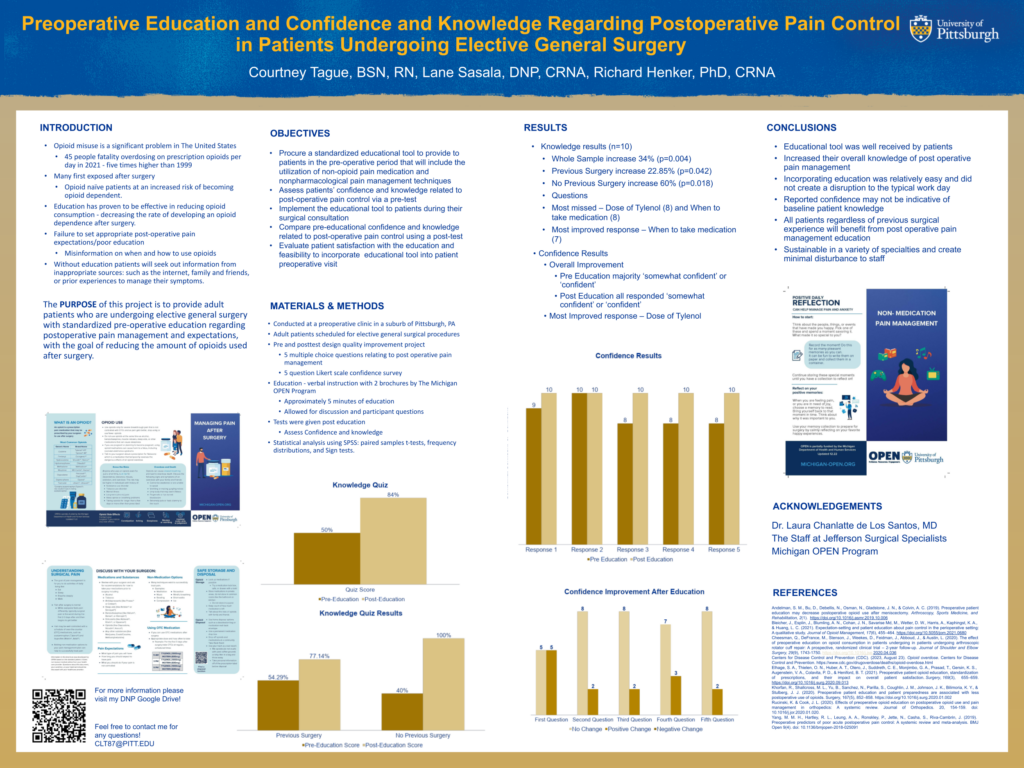Over the past year, Registered Nurse and current Nursing Anesthesia student at the University of Pittsburgh Courtney Tague utilized two OPEN brochures as a part of her Doctor of Nursing Practice (DNP) project. Her project, titled “Preoperative Education and Confidence and Knowledge Regarding Postoperative Pain Control in Patients Undergoing Elective General Surgery,” looked at how preoperative education affected the impact and confidence of postoperative pain management.
“I noticed patients were prepared for what the surgery would entail but were unprepared for what afterwards would look like. They didn’t understand what pain after surgery would be like,” stated Tague when discussing the beginnings of her project. Tague began searching for educational materials that fit the Joint Commission (JCAHO) standards, which help health organizations and hospitals develop strategies to address complex issues and identify key vulnerabilities in the patient care experience.
“When I found the OPEN materials, they ticked every box. They had a pain management plan, they had opioid storage and disposal strategies. They had everything.” Tague ultimately decided on using OPEN’s Managing Pain After Surgery and Non-Medication Pain Management brochures to discuss acceptable pain levels, non-opioid medications and techniques, opioid storage and disposal, and opioid use and side effects.
Before interacting with patients, Tague planned a pre and post education quiz for not just tracking knowledge, but confidence in pain management postoperative. The knowledge quiz included 5 questions and asked patients various questions on how to manage their pain at home. The confidence survey also included 5 questions, each on a Likert scale from 1-5, based on their confidence of managing their pain from home.
Tague would meet with patients, present them with the pre-quizzes, provide a 5-minute education, then present the post quiz. “I provided the education myself, and because we had no one in my program that really has done something like this (directly educating patients), I was essentially creating a pilot program for this work. I worked out when during the visit this education occurred, how long it would last, how I would use the materials.”
Tague discussed the benefit of this method, stating that she was able to circle points and write notes on the brochures that would go home with patients, and that a few patients themselves took their own notes. When talking about why these materials worked well for this education, she stated “It doesn’t describe the pain or pinpoint the pain, which means that this resource [Managing Pain After Surgery] can be used for any surgery. It started a discussion with the patient, and it became a situation where we were discussing together instead of me talking to them. The discussion builds trust between you and the patient.”
In total, Tague met with a sample of 10 patients, all of whom agreed to participate. After meeting with her patients, she took back the pre and post-education quizzes and analyzed the results. “The pre-education confidence was very high, above 80%. However, the pre-education knowledge was very low, only 50%. It was interesting because we were asking them if they were confident and they said yes, but it seemed like they didn’t know what they were saying yes to.”
A result that came at surprise to Tague was that two of the most missed questions, both with 8 incorrect answers in the pre-quiz, were what dose of Tylenol to take and when to take their pain medication.

Another surprise came when looking at the difference between patients who have had surgery before and those who were about to have their first operation. “Those who have had surgery in the past were less confident than those who have never had a surgery up to this point.” Despite a lower confidence pre-education, those who have had a surgery previously did have more knowledge on their pain management, with 54% compared to 40% for those who were there for their first surgery.
Overall, post-education knowledge increased to 84%, and confidence grew to 100%. “I asked all 10 patients for their satisfaction with the materials… and every patient stated they were satisfied with the materials themselves.”
Tague stated this project is important because it shows that implementation can be as easy as discussing safety measures or pain management strategies at any time from the first meeting to scheduling future appointments. “This was a proof-of-concept type of implementation project. People are always asking how we are going to implement education during visits, and I was able to do so in a streamlined process and saw patients leave more confident and more informed on what their surgery and pain afterwards would look like.”
Seeing patients leave with more confidence wasn’t the only bright take away that Tague would leave with. Completing her work with patients and analyzing the results from her work has pushed Tague to examine future studies in this space more closely. “It was nice going through this process because it has made me more critical of future studies that come out. I know what information to look for, how to tell if something is credible or reliable.”
Tague presented the findings of her work in April 2024.